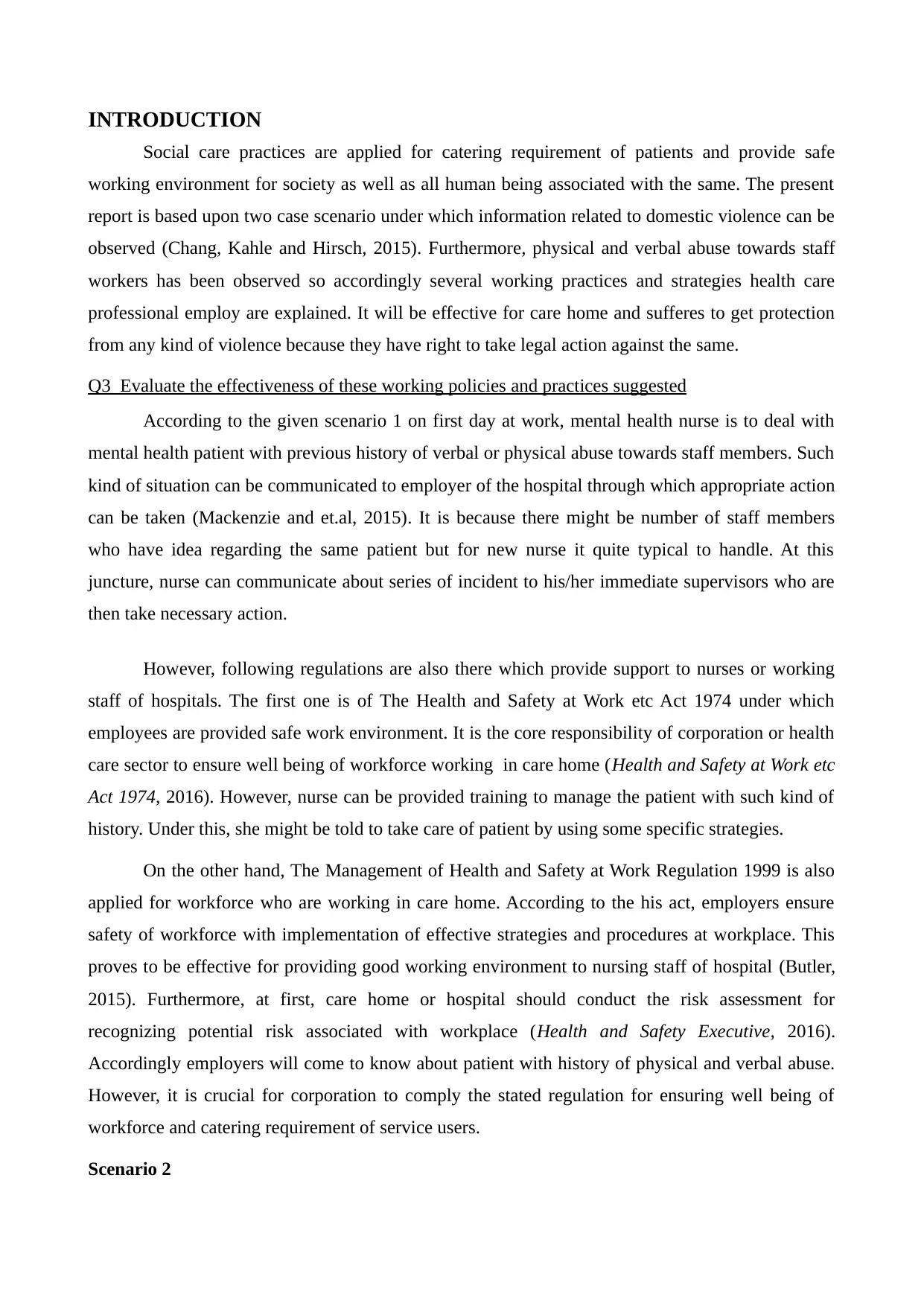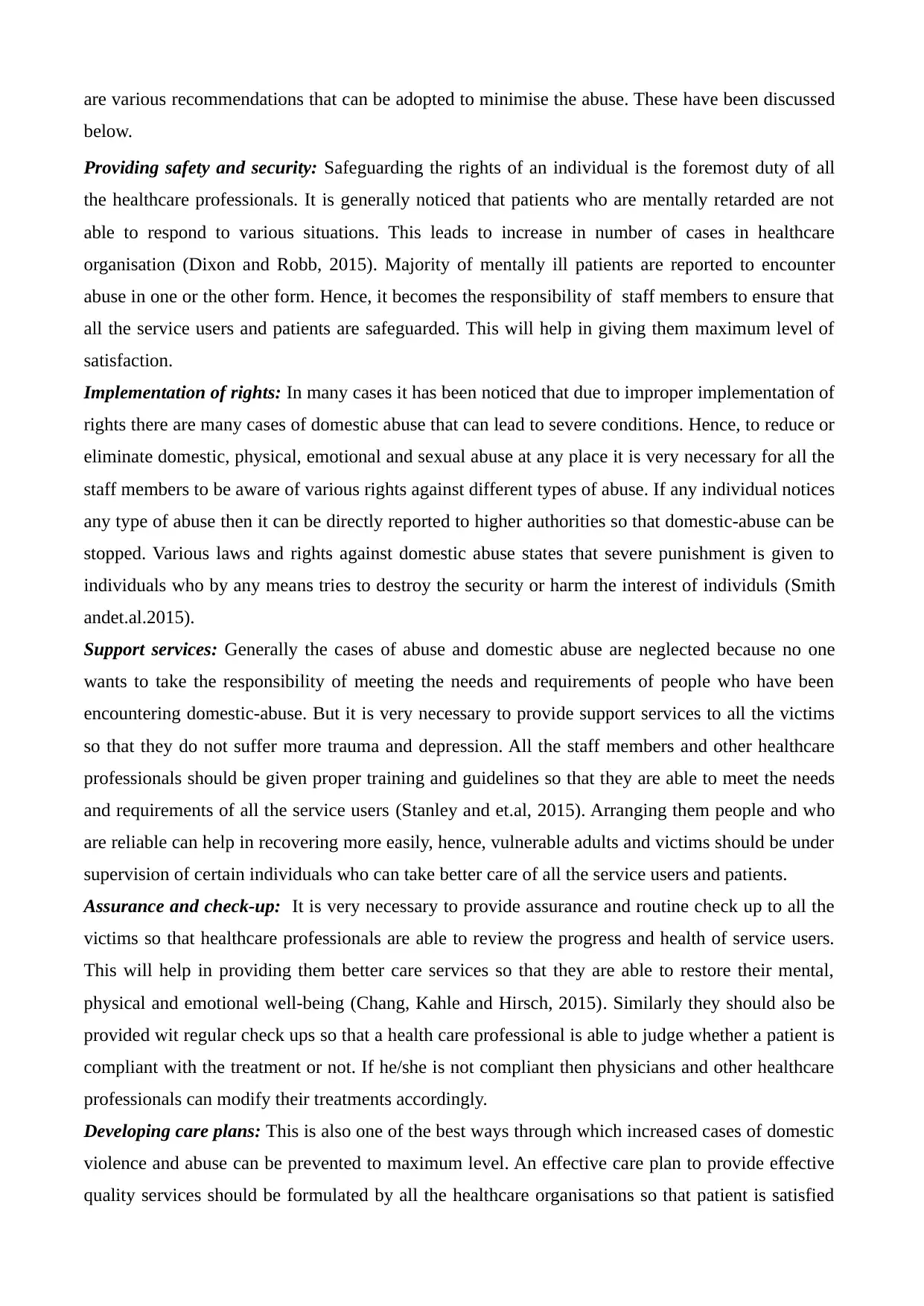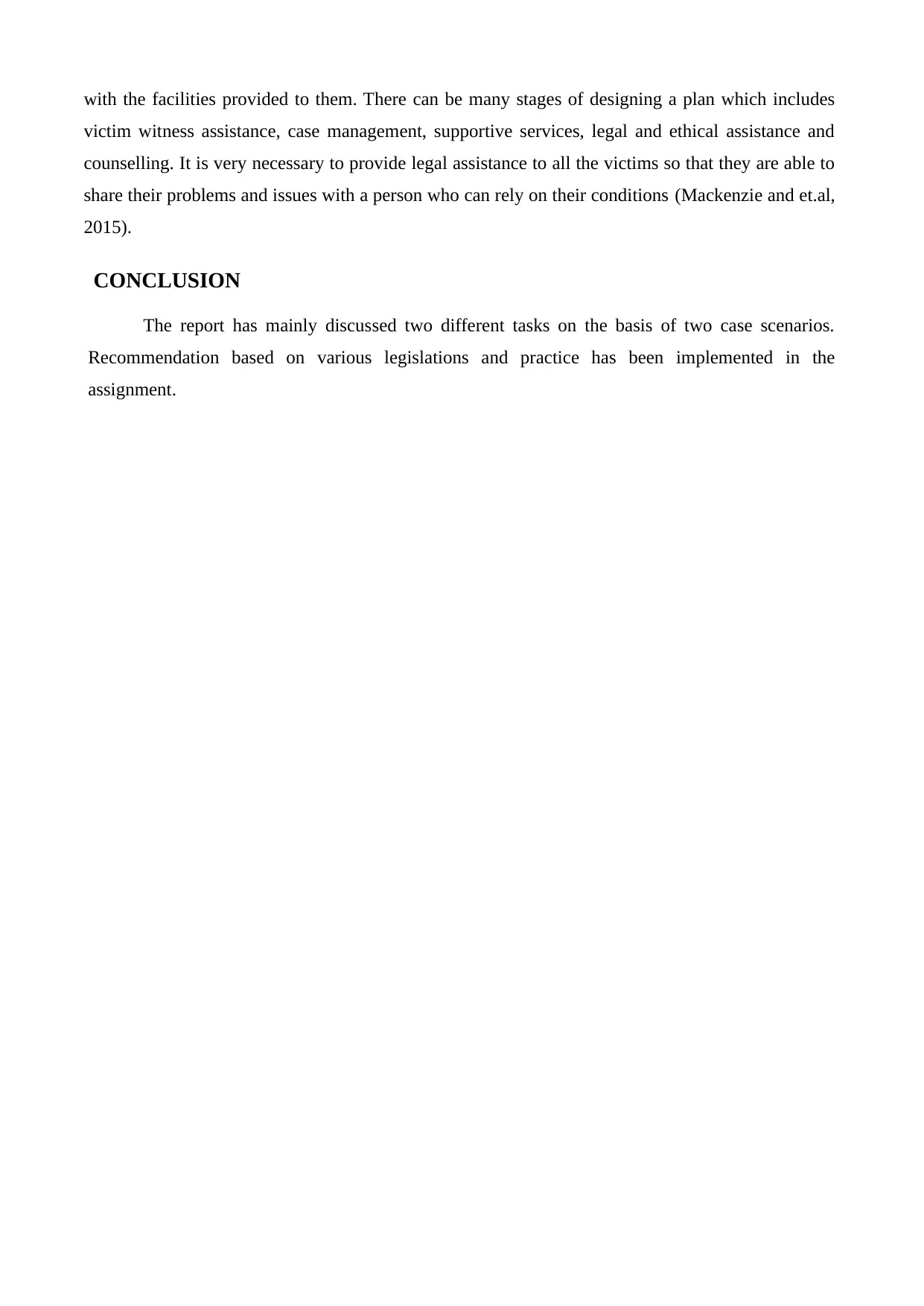Case Scenarios in Healthcare: Domestic Abuse, Policies, and Practices
VerifiedAdded on 2020/01/28
|7
|2209
|52
Report
AI Summary
This report presents an analysis of two case scenarios centered on domestic abuse within healthcare settings. The first scenario involves a mental health nurse dealing with a patient with a history of abuse, while the second focuses on a pregnant woman experiencing domestic violence from her ex-husband. The report evaluates the effectiveness of current working policies and practices, including The Health and Safety at Work etc Act 1974 and The Management of Health and Safety at Work Regulation 1999, and relevant legislation such as the Domestic Violence and Protection Orders Act 2008 and the Protection of Women against Domestic violence Act 2005. Recommendations are provided to minimize abuse, emphasizing the importance of safety, implementation of rights, support services, assurance, and the development of care plans. The report concludes with a discussion on how to improve staff collaboration to address and prevent domestic abuse, highlighting the need for training and awareness to protect both patients and staff.

Case Scenario
Paraphrase This Document
Need a fresh take? Get an instant paraphrase of this document with our AI Paraphraser

INTRODUCTION
Social care practices are applied for catering requirement of patients and provide safe
working environment for society as well as all human being associated with the same. The present
report is based upon two case scenario under which information related to domestic violence can be
observed (Chang, Kahle and Hirsch, 2015). Furthermore, physical and verbal abuse towards staff
workers has been observed so accordingly several working practices and strategies health care
professional employ are explained. It will be effective for care home and sufferes to get protection
from any kind of violence because they have right to take legal action against the same.
Q3 Evaluate the effectiveness of these working policies and practices suggested
According to the given scenario 1 on first day at work, mental health nurse is to deal with
mental health patient with previous history of verbal or physical abuse towards staff members. Such
kind of situation can be communicated to employer of the hospital through which appropriate action
can be taken (Mackenzie and et.al, 2015). It is because there might be number of staff members
who have idea regarding the same patient but for new nurse it quite typical to handle. At this
juncture, nurse can communicate about series of incident to his/her immediate supervisors who are
then take necessary action.
However, following regulations are also there which provide support to nurses or working
staff of hospitals. The first one is of The Health and Safety at Work etc Act 1974 under which
employees are provided safe work environment. It is the core responsibility of corporation or health
care sector to ensure well being of workforce working in care home (Health and Safety at Work etc
Act 1974, 2016). However, nurse can be provided training to manage the patient with such kind of
history. Under this, she might be told to take care of patient by using some specific strategies.
On the other hand, The Management of Health and Safety at Work Regulation 1999 is also
applied for workforce who are working in care home. According to the his act, employers ensure
safety of workforce with implementation of effective strategies and procedures at workplace. This
proves to be effective for providing good working environment to nursing staff of hospital (Butler,
2015). Furthermore, at first, care home or hospital should conduct the risk assessment for
recognizing potential risk associated with workplace (Health and Safety Executive, 2016).
Accordingly employers will come to know about patient with history of physical and verbal abuse.
However, it is crucial for corporation to comply the stated regulation for ensuring well being of
workforce and catering requirement of service users.
Scenario 2
Social care practices are applied for catering requirement of patients and provide safe
working environment for society as well as all human being associated with the same. The present
report is based upon two case scenario under which information related to domestic violence can be
observed (Chang, Kahle and Hirsch, 2015). Furthermore, physical and verbal abuse towards staff
workers has been observed so accordingly several working practices and strategies health care
professional employ are explained. It will be effective for care home and sufferes to get protection
from any kind of violence because they have right to take legal action against the same.
Q3 Evaluate the effectiveness of these working policies and practices suggested
According to the given scenario 1 on first day at work, mental health nurse is to deal with
mental health patient with previous history of verbal or physical abuse towards staff members. Such
kind of situation can be communicated to employer of the hospital through which appropriate action
can be taken (Mackenzie and et.al, 2015). It is because there might be number of staff members
who have idea regarding the same patient but for new nurse it quite typical to handle. At this
juncture, nurse can communicate about series of incident to his/her immediate supervisors who are
then take necessary action.
However, following regulations are also there which provide support to nurses or working
staff of hospitals. The first one is of The Health and Safety at Work etc Act 1974 under which
employees are provided safe work environment. It is the core responsibility of corporation or health
care sector to ensure well being of workforce working in care home (Health and Safety at Work etc
Act 1974, 2016). However, nurse can be provided training to manage the patient with such kind of
history. Under this, she might be told to take care of patient by using some specific strategies.
On the other hand, The Management of Health and Safety at Work Regulation 1999 is also
applied for workforce who are working in care home. According to the his act, employers ensure
safety of workforce with implementation of effective strategies and procedures at workplace. This
proves to be effective for providing good working environment to nursing staff of hospital (Butler,
2015). Furthermore, at first, care home or hospital should conduct the risk assessment for
recognizing potential risk associated with workplace (Health and Safety Executive, 2016).
Accordingly employers will come to know about patient with history of physical and verbal abuse.
However, it is crucial for corporation to comply the stated regulation for ensuring well being of
workforce and catering requirement of service users.
Scenario 2

According to the scenario, A woman is suffering from domestic abuse from her ex-husband.
Recently she has reported that she has got pregnant for 3 months. She is scared to live with that
man because of domestic abuses as she has bruises all over her face and neck just because of that
particular man (Bradbury‐Jones and Broadhurst, 2015). At this juncture, different regulations are in
place which can be applied by health care organization to resolve the issues which is being faced by
that particular lady. For this purpose, following regulations can be imposed by care home. The first
one is of Domestic Violence and protection Orders Act 2008 through which protection can be
provided to suffered and accordingly her pregnancy time can be completed with safety.
The another act is of Protection of Women against Domestic violence Act 2005:Under this,
service users will get benefit because her ex-husband is legally bound for his misconduct. This act
covers different aspects such as physical abuse, emotional, social and economic humiliation as well
as mental. At this juncture, care home can provide protection to woman and safe environment can
be provided to her (What is a Domestic Violence Protection Order (DVPO)?, 2016). Apart from
this, other related regulations are also there which can be used by care home and expenses can be
incurred on sufferer for providing her free of cost treatment. Moreover, Multi-Agency Risk
assessment conferences works with main purpose to share all information related to safety. Under
this, care home can protect pregnant lady who is being abused from her ex-husband.
Apart from this, under both cases management of hospitals can gather detail information from
sufferers and accordingly they can be protected by using appropriate strategies. Here, nursing staff
should provide intensive care to such kind of patients and accordingly their issues can be resolved
with time. However, social workers can effectively provide protection to such kind of services with
consultation of local authorities (Malpass, Sales and Feder, 2015). This is because government offer
free treatment also for some specific patients and liable people might be punished. However, patient
can be suggested to take legal action against her ex-husband for better protection. Thus, suggested
approaches are effective for providing relied to patients in both scenario.
Q4. Discuss your recommendation for improvement with other members of staff to minimise abuse
Before, recommending various suggestions for the improvement with other staff members to
minimise abuse it is very important to identify the extent of abuse a person is suffering from. In the
given case scenarios there are two cases in both the individuals are facing some or the other kind of
abuse (Salmon, Baird and White, 2015). In the second case scenario it can be clearly seen that a
woman has been facing severe issues of domestic-abuse from her husband and has reported marks of
bruises and attacks on neck and her face. In such case it is the responsibility of healthcare
professionals toS address this issue so that the female individual do not encounter any trauma. There
Recently she has reported that she has got pregnant for 3 months. She is scared to live with that
man because of domestic abuses as she has bruises all over her face and neck just because of that
particular man (Bradbury‐Jones and Broadhurst, 2015). At this juncture, different regulations are in
place which can be applied by health care organization to resolve the issues which is being faced by
that particular lady. For this purpose, following regulations can be imposed by care home. The first
one is of Domestic Violence and protection Orders Act 2008 through which protection can be
provided to suffered and accordingly her pregnancy time can be completed with safety.
The another act is of Protection of Women against Domestic violence Act 2005:Under this,
service users will get benefit because her ex-husband is legally bound for his misconduct. This act
covers different aspects such as physical abuse, emotional, social and economic humiliation as well
as mental. At this juncture, care home can provide protection to woman and safe environment can
be provided to her (What is a Domestic Violence Protection Order (DVPO)?, 2016). Apart from
this, other related regulations are also there which can be used by care home and expenses can be
incurred on sufferer for providing her free of cost treatment. Moreover, Multi-Agency Risk
assessment conferences works with main purpose to share all information related to safety. Under
this, care home can protect pregnant lady who is being abused from her ex-husband.
Apart from this, under both cases management of hospitals can gather detail information from
sufferers and accordingly they can be protected by using appropriate strategies. Here, nursing staff
should provide intensive care to such kind of patients and accordingly their issues can be resolved
with time. However, social workers can effectively provide protection to such kind of services with
consultation of local authorities (Malpass, Sales and Feder, 2015). This is because government offer
free treatment also for some specific patients and liable people might be punished. However, patient
can be suggested to take legal action against her ex-husband for better protection. Thus, suggested
approaches are effective for providing relied to patients in both scenario.
Q4. Discuss your recommendation for improvement with other members of staff to minimise abuse
Before, recommending various suggestions for the improvement with other staff members to
minimise abuse it is very important to identify the extent of abuse a person is suffering from. In the
given case scenarios there are two cases in both the individuals are facing some or the other kind of
abuse (Salmon, Baird and White, 2015). In the second case scenario it can be clearly seen that a
woman has been facing severe issues of domestic-abuse from her husband and has reported marks of
bruises and attacks on neck and her face. In such case it is the responsibility of healthcare
professionals toS address this issue so that the female individual do not encounter any trauma. There
⊘ This is a preview!⊘
Do you want full access?
Subscribe today to unlock all pages.

Trusted by 1+ million students worldwide

are various recommendations that can be adopted to minimise the abuse. These have been discussed
below.
Providing safety and security: Safeguarding the rights of an individual is the foremost duty of all
the healthcare professionals. It is generally noticed that patients who are mentally retarded are not
able to respond to various situations. This leads to increase in number of cases in healthcare
organisation (Dixon and Robb, 2015). Majority of mentally ill patients are reported to encounter
abuse in one or the other form. Hence, it becomes the responsibility of staff members to ensure that
all the service users and patients are safeguarded. This will help in giving them maximum level of
satisfaction.
Implementation of rights: In many cases it has been noticed that due to improper implementation of
rights there are many cases of domestic abuse that can lead to severe conditions. Hence, to reduce or
eliminate domestic, physical, emotional and sexual abuse at any place it is very necessary for all the
staff members to be aware of various rights against different types of abuse. If any individual notices
any type of abuse then it can be directly reported to higher authorities so that domestic-abuse can be
stopped. Various laws and rights against domestic abuse states that severe punishment is given to
individuals who by any means tries to destroy the security or harm the interest of individuls (Smith
andet.al.2015).
Support services: Generally the cases of abuse and domestic abuse are neglected because no one
wants to take the responsibility of meeting the needs and requirements of people who have been
encountering domestic-abuse. But it is very necessary to provide support services to all the victims
so that they do not suffer more trauma and depression. All the staff members and other healthcare
professionals should be given proper training and guidelines so that they are able to meet the needs
and requirements of all the service users (Stanley and et.al, 2015). Arranging them people and who
are reliable can help in recovering more easily, hence, vulnerable adults and victims should be under
supervision of certain individuals who can take better care of all the service users and patients.
Assurance and check-up: It is very necessary to provide assurance and routine check up to all the
victims so that healthcare professionals are able to review the progress and health of service users.
This will help in providing them better care services so that they are able to restore their mental,
physical and emotional well-being (Chang, Kahle and Hirsch, 2015). Similarly they should also be
provided wit regular check ups so that a health care professional is able to judge whether a patient is
compliant with the treatment or not. If he/she is not compliant then physicians and other healthcare
professionals can modify their treatments accordingly.
Developing care plans: This is also one of the best ways through which increased cases of domestic
violence and abuse can be prevented to maximum level. An effective care plan to provide effective
quality services should be formulated by all the healthcare organisations so that patient is satisfied
below.
Providing safety and security: Safeguarding the rights of an individual is the foremost duty of all
the healthcare professionals. It is generally noticed that patients who are mentally retarded are not
able to respond to various situations. This leads to increase in number of cases in healthcare
organisation (Dixon and Robb, 2015). Majority of mentally ill patients are reported to encounter
abuse in one or the other form. Hence, it becomes the responsibility of staff members to ensure that
all the service users and patients are safeguarded. This will help in giving them maximum level of
satisfaction.
Implementation of rights: In many cases it has been noticed that due to improper implementation of
rights there are many cases of domestic abuse that can lead to severe conditions. Hence, to reduce or
eliminate domestic, physical, emotional and sexual abuse at any place it is very necessary for all the
staff members to be aware of various rights against different types of abuse. If any individual notices
any type of abuse then it can be directly reported to higher authorities so that domestic-abuse can be
stopped. Various laws and rights against domestic abuse states that severe punishment is given to
individuals who by any means tries to destroy the security or harm the interest of individuls (Smith
andet.al.2015).
Support services: Generally the cases of abuse and domestic abuse are neglected because no one
wants to take the responsibility of meeting the needs and requirements of people who have been
encountering domestic-abuse. But it is very necessary to provide support services to all the victims
so that they do not suffer more trauma and depression. All the staff members and other healthcare
professionals should be given proper training and guidelines so that they are able to meet the needs
and requirements of all the service users (Stanley and et.al, 2015). Arranging them people and who
are reliable can help in recovering more easily, hence, vulnerable adults and victims should be under
supervision of certain individuals who can take better care of all the service users and patients.
Assurance and check-up: It is very necessary to provide assurance and routine check up to all the
victims so that healthcare professionals are able to review the progress and health of service users.
This will help in providing them better care services so that they are able to restore their mental,
physical and emotional well-being (Chang, Kahle and Hirsch, 2015). Similarly they should also be
provided wit regular check ups so that a health care professional is able to judge whether a patient is
compliant with the treatment or not. If he/she is not compliant then physicians and other healthcare
professionals can modify their treatments accordingly.
Developing care plans: This is also one of the best ways through which increased cases of domestic
violence and abuse can be prevented to maximum level. An effective care plan to provide effective
quality services should be formulated by all the healthcare organisations so that patient is satisfied
Paraphrase This Document
Need a fresh take? Get an instant paraphrase of this document with our AI Paraphraser

with the facilities provided to them. There can be many stages of designing a plan which includes
victim witness assistance, case management, supportive services, legal and ethical assistance and
counselling. It is very necessary to provide legal assistance to all the victims so that they are able to
share their problems and issues with a person who can rely on their conditions (Mackenzie and et.al,
2015).
CONCLUSION
The report has mainly discussed two different tasks on the basis of two case scenarios.
Recommendation based on various legislations and practice has been implemented in the
assignment.
victim witness assistance, case management, supportive services, legal and ethical assistance and
counselling. It is very necessary to provide legal assistance to all the victims so that they are able to
share their problems and issues with a person who can rely on their conditions (Mackenzie and et.al,
2015).
CONCLUSION
The report has mainly discussed two different tasks on the basis of two case scenarios.
Recommendation based on various legislations and practice has been implemented in the
assignment.

REFERENCES
Books and Journals
Chang, E.C., Kahle, E.R. and Hirsch, J.K., 2015. Understanding How Domestic Abuse Is
Associated With Greater Depressive Symptoms in a Community Sample of Female Primary
Care Patients Does Loss of Belongingness Matter?. Violence against women.
Mackenzie, M. and et.al., 2015. Intersections and Multiple ‘Candidacies’: Exploring Connections
between Two Theoretical Perspectives on Domestic Abuse and Their Implications for
Practicing Policy. Social Policy and Society. 14(01). pp.43-62.
Butler, T.T., 2015. The Times: Are They a-Changin’? Saudi Law Finally Addresses Domestic
Violence with Its Regulation on Protection from Abuse. Iowa Law Review. 100(3).
Bradbury‐Jones, C. and Broadhurst, K., 2015. Are we failing to prepare nursing and midwifery
students to deal with domestic abuse? Findings from a qualitative study. Journal of advanced
nursing. 71(9). pp.2062-2072.
Malpass, A., Sales, K. and Feder, G., 2015. Reducing symbolic‐violence in the research encounter:
collaborating with a survivor of domestic abuse in a qualitative study in UK primary care.
Sociology of Health & Illness.
Salmon, D., Baird, K.M. and White, P., 2015. Women's views and experiences of antenatal enquiry
for domestic abuse during pregnancy. Health Expectations.18(5). pp.867-878.
Holt, S., 2015. Post‐separation Fathering and Domestic Abuse: Challenges and Contradictions.
Child Abuse Review. 24(3). pp.210-222.
Dixon, J. and Robb, M., 2015. Working with women with a learning disability experiencing
domestic abuse: how social workers can negotiate competing definitions of risk. British
Journal of Social Work. p.bcu149.
Robinson, A.L., Pinchevsky, G.M. and Guthrie, J.A., 2016. A small constellation: risk factors
informing police perceptions of domestic abuse. Policing and Society. pp.1-16.
Stanley, N. and et.al., 2015. Preventing domestic abuse for children and young people (PEACH): a
mixed knowledge scoping review. Public Health Research. 3(7).
Online
What is a Domestic Violence Protection Order (DVPO)?. 2016. [Online]. Available through:
<http://www.sussex.police.uk/help-centre/ask-us/domestic-abuse/what-is-a-domestic-
violence-protection-order-%28dvpo%29>. [Accessed on 5th March 2016].
Health and Safety at Work etc Act 1974. 2016. [Online]. Available through:
<http://www.hse.gov.uk/legislation/hswa.htm>. [Accessed on 5th March 2016].
Health and Safety Executive. 2016. [Online]. Available through:
<http://www.hse.gov.uk/toolbox/index.htm>. [Accessed on 5th March 2016].
Books and Journals
Chang, E.C., Kahle, E.R. and Hirsch, J.K., 2015. Understanding How Domestic Abuse Is
Associated With Greater Depressive Symptoms in a Community Sample of Female Primary
Care Patients Does Loss of Belongingness Matter?. Violence against women.
Mackenzie, M. and et.al., 2015. Intersections and Multiple ‘Candidacies’: Exploring Connections
between Two Theoretical Perspectives on Domestic Abuse and Their Implications for
Practicing Policy. Social Policy and Society. 14(01). pp.43-62.
Butler, T.T., 2015. The Times: Are They a-Changin’? Saudi Law Finally Addresses Domestic
Violence with Its Regulation on Protection from Abuse. Iowa Law Review. 100(3).
Bradbury‐Jones, C. and Broadhurst, K., 2015. Are we failing to prepare nursing and midwifery
students to deal with domestic abuse? Findings from a qualitative study. Journal of advanced
nursing. 71(9). pp.2062-2072.
Malpass, A., Sales, K. and Feder, G., 2015. Reducing symbolic‐violence in the research encounter:
collaborating with a survivor of domestic abuse in a qualitative study in UK primary care.
Sociology of Health & Illness.
Salmon, D., Baird, K.M. and White, P., 2015. Women's views and experiences of antenatal enquiry
for domestic abuse during pregnancy. Health Expectations.18(5). pp.867-878.
Holt, S., 2015. Post‐separation Fathering and Domestic Abuse: Challenges and Contradictions.
Child Abuse Review. 24(3). pp.210-222.
Dixon, J. and Robb, M., 2015. Working with women with a learning disability experiencing
domestic abuse: how social workers can negotiate competing definitions of risk. British
Journal of Social Work. p.bcu149.
Robinson, A.L., Pinchevsky, G.M. and Guthrie, J.A., 2016. A small constellation: risk factors
informing police perceptions of domestic abuse. Policing and Society. pp.1-16.
Stanley, N. and et.al., 2015. Preventing domestic abuse for children and young people (PEACH): a
mixed knowledge scoping review. Public Health Research. 3(7).
Online
What is a Domestic Violence Protection Order (DVPO)?. 2016. [Online]. Available through:
<http://www.sussex.police.uk/help-centre/ask-us/domestic-abuse/what-is-a-domestic-
violence-protection-order-%28dvpo%29>. [Accessed on 5th March 2016].
Health and Safety at Work etc Act 1974. 2016. [Online]. Available through:
<http://www.hse.gov.uk/legislation/hswa.htm>. [Accessed on 5th March 2016].
Health and Safety Executive. 2016. [Online]. Available through:
<http://www.hse.gov.uk/toolbox/index.htm>. [Accessed on 5th March 2016].
⊘ This is a preview!⊘
Do you want full access?
Subscribe today to unlock all pages.

Trusted by 1+ million students worldwide

1 out of 7
Related Documents
Your All-in-One AI-Powered Toolkit for Academic Success.
+13062052269
info@desklib.com
Available 24*7 on WhatsApp / Email
![[object Object]](/_next/static/media/star-bottom.7253800d.svg)
Unlock your academic potential
Copyright © 2020–2025 A2Z Services. All Rights Reserved. Developed and managed by ZUCOL.





